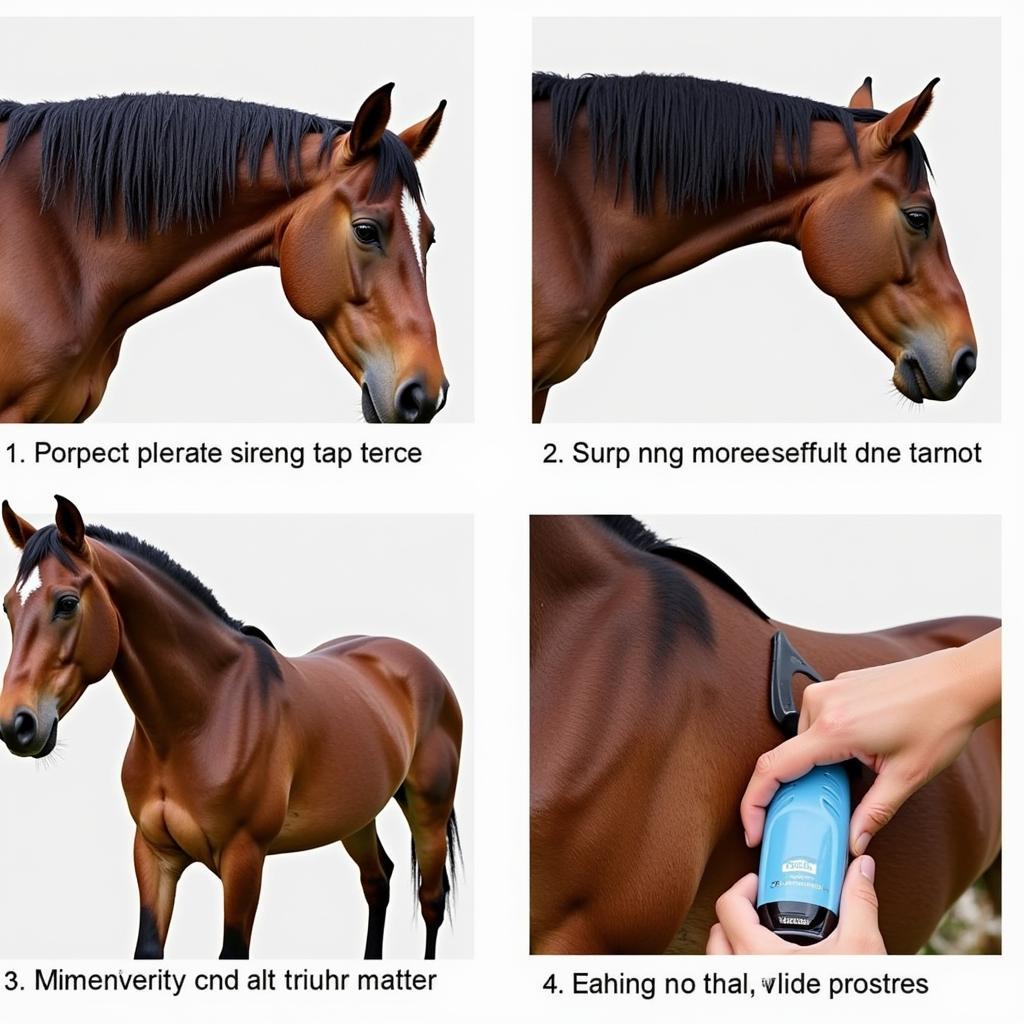Horse Shave is a crucial aspect of equine care, encompassing both the reasons for clipping and the various techniques involved. Whether you’re a seasoned horse owner or just beginning your equestrian journey, understanding the nuances of a horse shave can significantly impact your horse’s well-being. This article dives deep into the world of horse shaving, providing you with the knowledge and insights to make informed decisions for your equine companion.
Why Consider a Horse Shave?
Several factors contribute to the decision to give your horse a shave. Therapeutic reasons often top the list. A horse shave can help manage certain skin conditions, allowing for better application of medications and promoting faster healing. Performance enhancement is another key reason. A clipped coat can improve a horse’s performance, especially during strenuous activities, by allowing for efficient heat dissipation. Aesthetics also play a role. A neatly clipped horse presents a polished and professional appearance, particularly important in competitive settings.
Different Types of Horse Shaves
There are various types of horse shaves, each serving a specific purpose. The full body clip is the most comprehensive, removing hair from the entire body. This is often preferred for horses in intense training. A trace clip removes hair from the underside of the neck, chest, and belly, leaving the legs and back covered. This is a good option for horses who are worked moderately during colder months. A blanket clip, as the name suggests, removes hair from areas typically covered by a horse blanket, leaving a layer of insulation on the legs and back.
Essential Tools for a Horse Shave
Proper tools are essential for a safe and effective horse shave. High-quality clippers are a must. Investing in a good set of clippers designed specifically for horses will ensure a smooth and even clip.  Essential tools and equipment for clipping a horse Sharp blades are equally important. Dull blades can pull the hair, causing discomfort and an uneven clip. Clipper oil and coolant are essential for keeping the clippers running smoothly and preventing overheating.
Essential tools and equipment for clipping a horse Sharp blades are equally important. Dull blades can pull the hair, causing discomfort and an uneven clip. Clipper oil and coolant are essential for keeping the clippers running smoothly and preventing overheating.
Preparing Your Horse for a Shave
Preparation is key to a successful horse shave. Ensure your horse is clean and dry. A dirty coat can clog the clippers and make the process more difficult. Accustom your horse to the sound and feel of the clippers. This can be done by gradually introducing the clippers while the horse is being groomed. A calm and relaxed horse makes the entire process easier and safer.
The Shaving Process: Step-by-Step Guide
- Start with a clean, dry horse.
- Attach a sharp blade to the clippers.
- Apply clipper oil and coolant.
- Begin clipping in the direction of hair growth.
- Use smooth, even strokes.
- Take breaks to allow the clippers to cool down.
- Check the blades regularly for sharpness.
- Clean the clippers after each use.
 Step-by-step demonstration of clipping a horse
Step-by-step demonstration of clipping a horse
Caring for Your Clipped Horse
After a horse shave, proper care is crucial. A clipped horse is more susceptible to the cold, so adequate blanketing is essential, especially in colder climates. Regular grooming helps to keep the clipped coat clean and healthy. Monitor your horse for any signs of skin irritation or discomfort.
Conclusion
A horse shave is a valuable tool in equine management. Understanding the reasons, techniques, and aftercare involved in a horse shave allows you to provide the best possible care for your equine companion. By following the guidelines outlined in this article, you can ensure a safe, effective, and comfortable experience for both you and your horse. Remember to choose the right type of clip for your horse’s needs and always prioritize their comfort and well-being. For those interested in unique horse-related crafts, explore options like a wooden shave horse. If you’re looking for a stylish touch, check out our fashion shoot horse gallery.
FAQ
- How often should I shave my horse?
- What type of clippers are best for a horse shave?
- How do I prevent clipper burn?
- Can I shave my horse myself, or should I hire a professional?
- What type of blanket should I use on a clipped horse?
- How can I help my horse get used to the clippers?
- Are there any risks associated with shaving a horse?
Expert Insight:
Dr. Emily Carter, Equine Veterinarian: “A horse shave can be beneficial for managing various skin conditions, allowing for better access to the affected area and promoting faster healing.”
Sarah Miller, Professional Groomer: “Always prioritize the horse’s comfort during a shave. Take breaks and use a coolant to prevent overheating and discomfort.”
John Davis, Experienced Horse Trainer: “Clipping can significantly improve a horse’s performance, especially during strenuous activities, by aiding in efficient heat dissipation.” You might also be interested in horse shave design or where to find a shaving horse for sale. For bedding needs, check out our guide on wood shavings for horses.
When you need assistance, contact us at Phone: 0772127271, Email: [email protected] Or visit us at QGM2+WX2, Vị Trung, Vị Thuỷ, Hậu Giang, Việt Nam. We have a 24/7 customer care team.